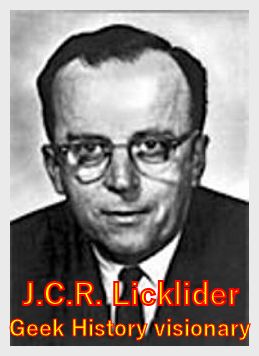 In the 1960s the vision of a worldwide network of computers by Dr. Joseph Carl Robnett Licklider would lead to the ARPANET.
In the 1960s the vision of a worldwide network of computers by Dr. Joseph Carl Robnett Licklider would lead to the ARPANET.
With the Soviet Union's launching of Sputnik, the first orbiting satellite, in 1957, President Dwight Eisenhower created the National Aeronautics and Space Administration (NASA) and Advanced Research Projects Agency (ARPA) to address the needs of technology research and development.
The goal of ARPA was to address the technology needs of the U.S Department of Defense. ARPA would be the parent of the computer network of the ARPANET.
Licklider guides ARPA Vision
J.C.R. Licklider, known by friends, colleagues, and casual acquaintances as "Lick," was the first to describe the concept he called the "Galactic Network."
In the paper “Man-Computer Symbiosis,” published in 1960, Licklider provided a guide for decades of computer research to follow. He envisioned a globally interconnected set of computers through which everyone could quickly access data and programs from any site.
In October 1962, Licklider was appointed head of the Information Processing Techniques Office (IPTO) at ARPA, the United States Department of Defense Advanced Research Projects Agency. The IPTO funded the research that led to the development of the ARPANET.
During his time as director of ARPA's Information Processing Techniques Office (IPTO) Licklider funded a research project headed by Robert Fano at MIT called Project MAC, a large mainframe computer that was designed to be shared by up to 30 simultaneous users, each sitting at a separate typewriter terminal. Project MAC (the Project on Mathematics and Computation) would develop groundbreaking research in operating systems, artificial intelligence, and the theory of computation.
Licklider sought out the leading computer research institutions in the U.S. and set up research contracts with them. Soon there were about a dozen universities and companies working on ARPA contracts including Stanford, UCLA, and Berkeley. Lick jokingly nicknamed his group the Intergalactic Computer Network. This group would later form the core who created the ARPANET.